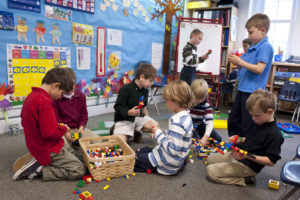
Separating boys and girls into different classrooms may make a lot of sense at the middle or high school levels, where budding attractions between the genders can distract young pre-teen and teenage students from the work of learning. But in kindergarten, does it really make a difference?
Many families who visit our all-boys private Pre-K and Kindergarten program wonder this. Is there any point to a single-sex education for boys this young, they ask, or is just a relic of a bygone era?
The truth is, single-sex education is far from an anachronism, even for children as young as pre-K or kindergarten; it’s an educational trend sweeping the nation. In the past five years, hundreds of single-sex classrooms have been established at public and private schools throughout the United States.
As a kindergarten teacher at The Fessenden School, Haley Cook has seen first-hand how 5-year-old boys benefit from a “no girls allowed” setting. In Haley’s experience, there are three main reasons kindergarten boys learn better in a single-sex classroom.
(For another of our teacher’s takes, read our recent article, 3 Reasons to Enroll Your Son in an All-Boys Kindergarten.)
- Everything is a ‘boy thing.’
 If you think back to your own early education, you probably remember certain activities were dominated by the boys and others by the girls. The boys would groan when they were asked to play make-believe or sing. The girls would drag their feet on the playing field.
If you think back to your own early education, you probably remember certain activities were dominated by the boys and others by the girls. The boys would groan when they were asked to play make-believe or sing. The girls would drag their feet on the playing field.
In an all-boys classroom, this never happens. Boys do not feel locked into traditional gender roles. As a result, they start exploring a wider range of human activities and feelings at a younger age.
“At Fessenden, singing and music class is a boy thing. Sports is a boy thing. Imaginative play is a boy thing,” Haley says. “Nothing is pegged as a girl thing or boy thing.”
For example, a group of boys in Haley’s class worked on a poem dedicated to their mothers called “Momma Says.” They were “really into it,” she says.
“At a coed school, this could have been thought of as a ‘girl thing,’ but here, everything is a boy thing,” she says.
- All-boys schools provide superior character education.
Would your son give another boy a hug if he saw he was having a bad day? At Fessenden boys are encouraged to be sensitive, caring, and loving — traits traditionally associated with girls.
“We promote kindness in the classroom,” Haley explains. “We ask them questions like, ‘How do you think that made your friend feel when you said that certain thing?’ There are lots of moments for reflection, so it becomes something the boys do innately.”
Haley recently witnessed a boy in her class taking the hand of another boy who was feeling down. He was playing the role of the “class comforter,” a role Fessenden kindergarteners take turns being responsible for where they’ll comfort friends, help take them to the nurse, and make sure they’re OK.
“It’s all about being part of a community here. From the beginning of the school year, the boys know that they are expected to be kind and loving.”
- All-boys schools tailor the curriculum to the learning styles of boys.
 You don’t need to have much experience with 5-year-old boys to know they have a lot of energy. In a coed classroom, this is a major challenge for teachers, as they try to balance their boys’ natural boisterousness with their girls’ relative calmness.
You don’t need to have much experience with 5-year-old boys to know they have a lot of energy. In a coed classroom, this is a major challenge for teachers, as they try to balance their boys’ natural boisterousness with their girls’ relative calmness.
In a single-sex classroom, there’s no need to strike that balance. The natural energy of young boys can be harnessed and channeled into productive learning activities.
 “There are times when young boys are able to just sit quietly, but there are also times when they need to move around,” Haley says.
“There are times when young boys are able to just sit quietly, but there are also times when they need to move around,” Haley says.
Haley recently helped her young students memorize the days of the week by getting up and stomping them out — then dancing the Macarena.
“It helped them get that energy out and use it in a positive way,” she says.
Haley’s kindergarten curriculum also includes plenty of hands-on learning. Multiple studies have shown this is one of the ways young boys learn best.
One example from Haley’s classroom: Her students recently made a map of the Fessenden campus and then programmed bee-bots to follow it. Another time, she led her boys on a walk through campus to talk about their community.
“These are the types of hands-on and engaging activities that play to the all-boys approach,” Haley notes.
See the single-sex advantage for yourself.
If you’re still skeptical about the benefits of a single-sex pre-K or kindergarten program, Haley encourages you to come see for yourself.
“It’s hard to imagine what a single-sex classroom looks like or feels like. Come see how wonderful the classrooms, facilities, and children really are,” she says. “When you visit, you will understand and fall in love with it.”
For a guide on asking the right questions when you visit a private pre-K or kindergarten program, follow this link for a free copy of the Pre-K & Kindergarten Private School Visit Checklist.
And if you have any questions about how a single-sex education would help your son learn, please ask them in the comments section below.





